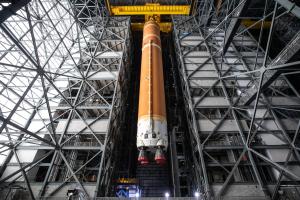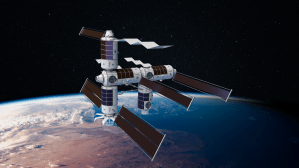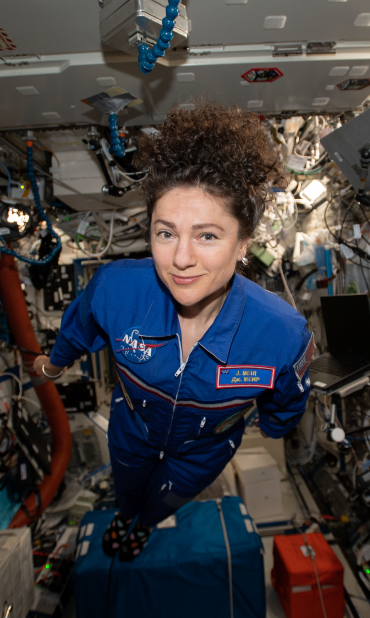Through Artemis, NASA astronauts are returning to the Moon in preparation for one day going to Mars. To better prepare astronauts for these long journeys, scientists need to know: How do extended durations in space change the human body?
Astronauts flying to the International Space Station can now volunteer for a suite of experiments that aim to help scientists learn more. Together, these experiments are called the Complement of Integrated Protocols for Human Exploration Research, or CIPHER.
 “CIPHER is the first study to integrate multiple physiological and psychological measures, giving us a chance to assess the whole human response to time spent in space,” CIPHER project scientist Cherie Oubre explains. “As more astronauts head to space through Artemis and other programs, we hope to learn more about how the various systems of the body, such as the heart, muscles, bones, and eyes, adapt to long-term spaceflight.”
“CIPHER is the first study to integrate multiple physiological and psychological measures, giving us a chance to assess the whole human response to time spent in space,” CIPHER project scientist Cherie Oubre explains. “As more astronauts head to space through Artemis and other programs, we hope to learn more about how the various systems of the body, such as the heart, muscles, bones, and eyes, adapt to long-term spaceflight.”
Through CIPHER, astronauts participate in an integrated set of 14 studies sponsored by NASA and international partner agencies. To get meaningful results, CIPHER scientists will study up to 30 astronauts, evenly divided over three mission-length categories:
- Short (less than 3.5 months in space)
- Standard (between 3.5 and eight months in space)
- Extended (more than eight months in space)
These research studies will monitor the health of astronauts before, during, and after their missions, and together address the following themes.
Bone and Joint Health
Studies show that astronauts lose bone density and muscle quality faster in space than on Earth. Calcium lost from bone ends up in their blood and urine. This loss of bone density may affect how skeletal systems support muscles and organs in space and soon after landing back on Earth.
Astronauts will:
- Undergo scans to measure bone density, skeletal health, and muscle quality surrounding bones and joints; and
- Collect blood and urine periodically before, during, and after their missions.
Scientists will:
- Examine whether the rate of bone and muscle loss stays constant, slows down, or even stops beyond six-month missions; and
- Determine what sort of health risks, if any, these pose.
Brain and Behavior
Fluids in the brain shift due to low gravity in space, and long-duration spaceflight may slightly alter brain structure. These changes could affect how the brain processes spatial information and, in turn, affect crew performance.
Astronauts will:
- Complete cognitive tests,
- Perform spatial cognition tasks using virtual reality,
- Use a computer to measure proficiency in controlling a robotic arm, and
- Undergo MRI scans while doing cognitive tests.
Scientists will:
- Examine how brain activity before missions differs from brain activity after missions,
- Pinpoint patterns dependent on mission duration, and
- Assess how changes in performance of cognitive, spatial cognition, and operational tasks relate to changes in brain structure and function.
Cardiovascular
Long-duration spaceflight may lead to stiffer arteries and increase the risk of heart disease. Scientists want to know how these changes play out during and after extended missions.
Astronauts will:
- Complete CT, MRI, and ultrasound imaging of the heart, surrounding organs and muscles, and blood vessels,
- Wear a shirt that measures heart rate and respiration across two days, and
- Take periodic blood pressure measurements.
Scientists will:
- Tease out patterns within and across mission durations to provide clear, objective indicators of cardiovascular health, and
- Examine whether the low-gravity affects organs, muscles, and vessels near the heart.
Exercise
Exercise is a well-known strategy to counter bone and muscle loss in space. Researchers want to understand whether exercise is an effective strategy for maintaining astronaut health in long-duration spaceflight.
Astronauts will:
- Test muscle strength and endurance throughout their missions using the station’s exercise equipment,
- Track their nutrition and sleep habits, and
- Navigate through an obstacle course after they land back on Earth, while at times wearing spacesuits connected to NASA’s Active Response Gravity Offload System, or ARGOS, to simulate Martian gravity.
Scientists will:
- Evaluate crews’ abilities to carry out specific exercises over time, and
- Evaluate how soon and how well crews can perform critical tasks in different gravities.
Sensorimotor

Credit: NASA
Many astronauts experience dizziness and disorientation when they arrive at the station and when they return to Earth. However, on future missions to Mars, ground support won’t be readily available to assist astronauts when they land on the Red Planet’s surface. Understanding factors that may influence how long these symptoms last will be important to mission success.
Astronauts will:
- Record their eye, head, and body movements using specialized techniques, and
- Fill out surveys on how they perceive motion.
Scientists will:
- See whether mission duration influences how long it takes to adapt to a different gravity level, and
- Investigate the reasons behind changes in balance and the ability to adapt to different gravities.
Vision
Because low-gravity conditions shift the body’s fluids toward the head, spaceflight can alter the structure and function of the eyes and the brain. This, in turn, may influence how astronauts process visual information on long missions, which could affect their performance.
Astronauts will:
- Participate in MRI and eye imaging scans,
- Perform vision tests, and
- Assess eye pressure and how the retina responds to light.
Scientists will:
- Evaluate eye changes for each mission duration, and
- See how the structure of astronauts’ brains change after their missions, and how such changes affect vision.
Biomarkers
Samples of astronaut’s blood and urine can provide insights into crew health. For instance, stress hormones reveal how the immune system reacts to spaceflight. Scientists want to know whether any changes to the human body induced by long-duration space travel come with indicators that can also be detected in blood and urine.
Astronauts will:
- Provide blood and urine samples before, during, and after spaceflight, and
- Complete questionnaires regarding health and exercise habits.
Scientists will:
- Examine blood and urine for potential indicators of changes to cartilage health, inflammation and immune function, kidney health, brain structure and function, spatial cognition, performance of operational tasks, risk of cardiovascular disease, and more; and
- Investigate the interplay between mission length, DNA damage responses, and post-mission recovery of telomeres – the caps at the ends of chromosomes that shorten as we age but may lengthen in space before rebalancing themselves back on Earth.
CIPHER also includes a long-running study called Spaceflight Standard Measures, which collects a core set of information on as many crew members as possible. This core set includes metrics about the crew member’s sleep, cognition, biomarkers, immune function, microbiome, and more.
In addition to answering research questions central to each study, CIPHER takes an integrated approach – data across the CIPHER investigations will be evaluated to identify patterns and gain a deeper understanding of how the human body reacts to long durations in space. For instance: Do changes to the various systems of the body plateau across the board after specific amounts of time spent in space? Do changes in one system herald changes in another?
“CIPHER is an all-encompassing, total-body approach to learning how humans adapt to spaceflight,” says Oubre. “Insights gained through CIPHER may well be key to enabling humans to remain healthy while exploring the Moon, Mars, and beyond.”
_____
NASA is leading a return to the Moon for long-term exploration. Through the Artemis missions, NASA will land the first woman and first person of color on the Moon, using innovative technologies to explore more of the lunar surface than ever before. Lessons learned on and around the Moon will prepare NASA for the next giant leap: sending astronauts to Mars.
Learn more about Artemis here.
_____
NASA’s Human Research Program, or HRP, pursues the best methods and technologies to support safe, productive human space travel. Through science conducted in laboratories, ground-based analogs, and the International Space Station, HRP scrutinizes how spaceflight affects human bodies and behaviors. Such research drives HRP’s quest to innovate ways that keep astronauts healthy and mission-ready as space travel expands to the Moon, Mars, and beyond.
Learn more about the Human Research Program here.




































